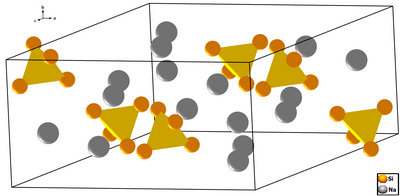Zintl phases
Zintl phases are intermetallic compounds between strongly electropositive alkali metals or alkaline earth metals and moderately electronegative elements from groups 11 to 16 of the periodic table . After Eduard Zintl's death, her name was proposed by Fritz Laves in honor of Zintl and quickly accepted.
In these compounds, the electron is formally assigned to the more electronegative element. According to E. Busmann and Wilhelm Klemm, the built-up anion partial lattice corresponds to that of an element structure with the same valence electron configuration . The Zintl border or line can be drawn between the 13th and 14th group ; it separates the salt-like phases from the alloy-like phases of the 11th to 13th group.
For example, the structure of the thallium anion partial lattice in sodium thallide (NaTl) corresponds to the face-centered cubic lattice , with half of the tetrahedral gaps again being occupied by Tl atoms. The sodium cations sit in the other half of the tetrahedral holes and in the octahedral holes in the crystal lattice . Another example is Natriumsilicid (NaSi), in analogy to the white phosphorus Si 4 4 - tetrahedron forms.
Many Zintl phases are due to the partly covalent , partly ionic bonds with the resulting relatively small band gap (<1 eV) diamagnetic semiconductors , the conductivity of which increases with increasing temperature in contrast to metallic conductors .
Polyanions
Zintl phases are formulated as ionic compounds according to the rule established by Zintl and expanded by Klemm. Zintl phases are strongly heteropolar, but often have the properties of a bad metal (electrical conductivity, metallic luster, etc.). For the discussion of the structures, however, the formal Ionic view is very well suited. With the formal electron transfer from the electropositive metal M to the electronegative partner E, anions are obtained whose structure follows the 8-N rule . This results in element-element bonds and a polyanionic structure is formed.
Examples
- NaSi: Si - : pseudo- phosphorus: [Si 4 ] 4− tetrahedron
- CaSi: Si 2− : pseudo -sulfur: Si chains (see μ-sulfur)
- Ca 2 Si: Si 4− : pseudo- argon: isolated Si atoms in the structure
- Ba 3 Si 4 : [Si 4 ] 6− : 2x Si - 2x Si 2− : distorted tetrahedra with two 2-bonded and two 3-bonded silicon atoms
Hydrides
There are a number of Zintl phases that also contain hydrogen in their structure. A distinction is made between Zintl phase hydrides , in which the hydrogen is present as H - and which are coordinated exclusively by the electropositive metal, and polyanionic hydrides , which in the polyanion have element-element bonds as well as element-hydrogen bonds. In polyanionic hydrides, the hydrogen is i. d. Usually the more electronegative partner, which gives it the -I oxidation state.
See also
literature
- Herbert Schäfer, Brigitte Eisenmann, Wiking Müller: Zintl phases: transition forms between metal and ionic bonds. In: Angew. Chem. 85, No. 17, 1973, pp. 742-760, doi : 10.1002 / anie.19730851704 .
Web links
Individual evidence
- ↑ Otto-Albrecht Neumüller (Ed.): Römpps Chemie-Lexikon. Volume 6: T-Z. 8th revised and expanded edition. Franckh'sche Verlagshandlung, Stuttgart 1988, ISBN 3-440-04516-1 , p. 4723.
- ^ AF Holleman , E. Wiberg , N. Wiberg : Textbook of Inorganic Chemistry . 101st edition. Walter de Gruyter, Berlin 1995, ISBN 3-11-012641-9 , p. 925.
- ↑ Ulrich Häussermann, Verina F. Kranak and Kati Puhakainen, Hydrogenous Zintl Phases: Interstitial Versus Polyanionic Hydrides In: Structure and Bonding 139, 2011, pp. 143–162 doi : 10.1007 / 430_2010_20

